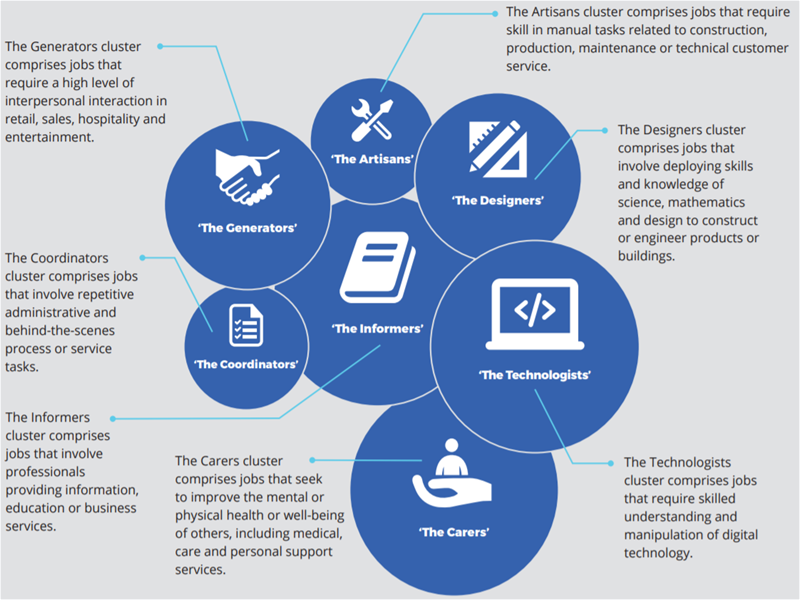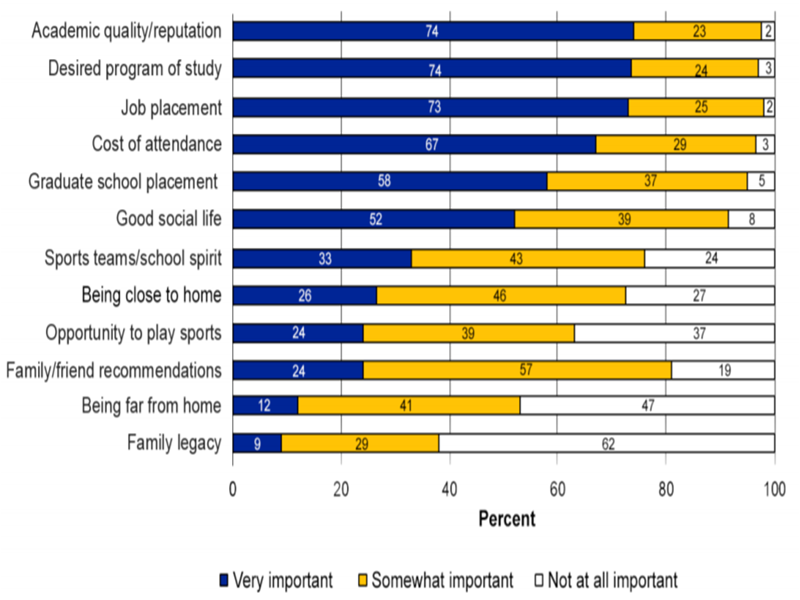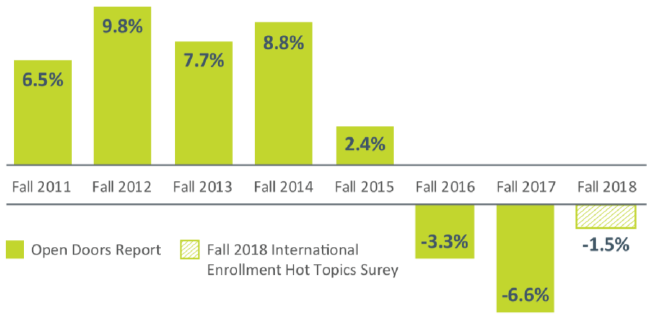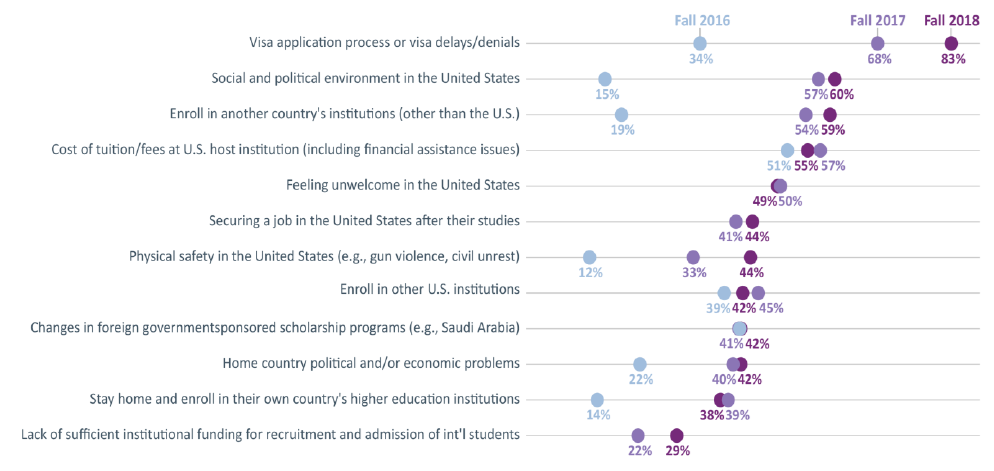Commentary: The fourth industrial revolution in post-secondary education
One of the plenary speakers at the SEM conference this year,
Janet Hyde, spoke about post-secondary education in the fourth industrial age. Among the many interesting points relating workplace skills and abilities to demand-driven education was an study that analyzed job openings in Australia and clustered jobs into seven categories (Figure1). I would hazard an educated guess that the seven Australian clusters are similar to those that would be found through a similar analysis in the United States and elsewhere. This career clustering reminds me of the move by some institutions to use career interest areas to lead students toward a program of study (e.g.,
ASU and
IUPUI). It behooves education and industry to work together to create career clusters like the Australian model to help students pick majors. Given the changing nature of workforce needs, an underlying presumption on this type of collaborative relationship is that the selection of career clusters used to route students to majors would need to be a dynamic model that is regularly updated based on the needs of the workforce. Just imagine the coordination this would bring between helping a student pick a major he/she is interested in and tying that directly to a cluster of current job openings.
Figure 1: Seven New Job Clusters (Australia)

Source:
https://www.fya.org.au/wp-content/uploads/2016/11/The-New-Work-Mindset.pdf
AACRAO Research Update
The November 60-Second survey on admissions practices feedback led me to believe we should complete a more comprehensive survey on the subject. As such, one is in the works. The highlights from the
60-Second report include the following:
Undergraduate practices
- Slightly more than half use holistic admissions methods.
- Less than a quarter use a self-reported high school GPA for an initial admit decision.
- Nearly a third use a waitlist for high demand programs.
- 60% require an enrollment deposit, and, of those, more than half require one that is $250 or less.
- One in ten is using a Chabot.
- More than three quarters are using a CRM.
- More than half make an admissions decision within a week once the application is considered actionable.
- 78% use enrollment projections to determine admissions targets.
Graduate practices
- Less than a quarter allow a student to enroll with an undeclared/undecided program of study.
- Slightly more than a third waitlist for high demand programs.
- 16% use a self-reported undergraduate GPA for an initial admit decision.
- One in ten is using a Chabot.
- Less than half require an enrollment deposit, and, of those, 46% require one that is $250 or less.
- More than half take two weeks or less to make an admit decision once the application is considered actionable.
- 56% use enrollment projections to determine admissions targets.
Criminal Justice Information – United States Institutions Only
- Half ask criminal justice questions in the admissions process.
- It is more prevalent for private, not-for-profit institutions to do so than public or private, proprietary.
- Lower division institutions are the least likely to ask this information.
Current Higher Education Research and Related Topics
Robot-Ready
The Strada Institute and EMSI released a report called Robot Ready: Human+ Skills for the Future of Work. In keeping with the theme from the SEM plenary speaker, Janet Hyde, this report examined education-to-employment pathways through the lens of skills gained by students who pursue a liberal arts field. The authors assert that it is “. . .time to focus on a Rosetta Stone that can translate skills between employers and post-secondary training systems by unpacking the granular meanings of human skills that are being supplied in the post-secondary programs and are in demand in the workforce.” They also conclude that liberal arts programs provide the skills necessary for today’s workforce and found that liberal arts graduates “. . . gravitate towards marketing careers” (Figure 2).
Figure 2: Paths of Liberal Arts Graduates

WICHE: Tuition and Fees in Public Higher Education in the West
WICHE released detailed data tables on tuition and fees and comparisons with previous data. The 10-year trend shows an increase of 45.8% for undergraduates at public four-year institutions and 30.7% at two-year institutions.
Five Models for the Future of Public Higher Education
The Deloitte Center for Higher Education Excellence and Georgia Tech’s Center for 21st Century Universities outline five possible models for the future of public higher education. The authors asked legislative staff members responsible for higher education policy about the issues they face. From these discussions, an analysis of several hundred strategic plans and an examination of the current state of public higher education in the United States, the authors developed five models: the sharing university, the entrepreneurial university, the experiential university; and the subscription university.
How College Students Use Advanced Placement (AP) Credit
- The author of a new article in the American Educational Research Journal used nationally representative data to identify a set of outcomes related to AP credit. Among other findings, he concluded the following about receipt of AP credit:
- “Highly and positively correlated with 4-year college enrollment and selective college attendance.”
- “Positively related to increased first-year GPA and an increased likelihood of receiving a bachelor’s degree within 6 years of initial enrollment.”
- 10 AP credits earned is associated with an approximate reduction in loan debt of $1,000
- No relationship between AP credits earned and STEM major selection.
- More likely to enroll in graduate school.
Factors that Influence Student College Choice
The U.S. Department of Education released a Data Point report on the factors that influence college choice based on the High School Longitudinal Study of 2009. Figure 3 below is from that report.
Figure 3: Factors Students Rate as Important When Choosing a School or College to Attend

NOTE: Percentages may not sum to 100 due to rounding.
SOURCE: U.S. Department of Education, Institute of Education Sciences, National Center for Education Statistics. High School Longitudinal Study of 2009 (HSLS:09) First Follow-up Public-Use Data File (NCES 2014-358).
Fall 2018 International Student Hot Topics
The Institute for International Education (IIE) partnered with AACRAO and others to survey 540 institutions. The data indicates that there is a continued trend downward of new international students. But the percentage decline is less than last year, and the reasons for the declines are shifting (see figures from the report below).
Figure 4: Percent Change of New International Student Enrollment

Figure 5: Top 12 Reasons for Declining International Students Fall 2016, Fall 2017, Fall 2018

CUPA Focuses on Student Affairs in Its Latest Report
- CUPA used their own data to examine the profile of student affairs professionals and tied that data to the ability of colleges and universities to serve students as individuals. Among their findings are the following:
- Student affairs is predominantly female.
- The staff are not as diverse as the students they serve.
- Pay equity for women and minorities is less of an issue in student affairs compared to the rest of higher education.
- The number of new mental health counselor positions has increased faster than the average for other positions in student affairs for 2017-18.
2018 Survey of College and University Admissions Directors
In late September Inside Higher Ed and Gallup released the results of a survey of admissions directors. The purpose of this survey was to examine admissions policy and procedure issues through the lens of admissions directors. Survey topics ranged from meeting enrollment goals, the perceived usefulness of SAT and ACT scores, the practice of wait listing, concerns about loan debt, and factors affecting community college admissions, among others.